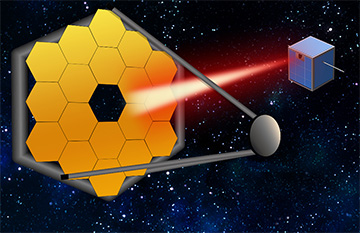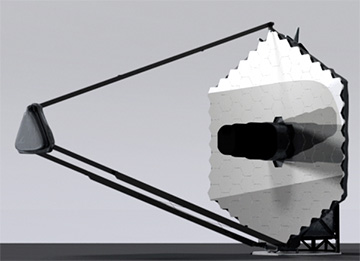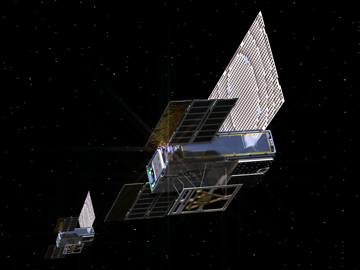
An MIT–University of Arizona team proposes using a fleet of laser-carrying CubeSats as guide stars to stabilize and calibrate giant space telescopes as the search for light from distant exoplanets. [Image: Christine Daniloff, MIT]
For several decades, ground-based astronomers have relied on laser-excited artificial “guide stars” in Earth’s middle atmosphere to sharpen their telescopes’ views of the cosmos. Now, a research team has proposed that a different kind of guide-star laser, mounted on formation-flying CubeSats, might help keep future generations of giant space-based telescopes on target as they peer at the faint reflected light of distant extrasolar planets (Astron. J., doi: 10.3847/1538-3881/aaf385).
Wavefront shaping
For ground-based telescopes, laser guide stars—glowing sodium atoms in the middle atmosphere, or mesosphere, excited by light from a ground-based continuous-wave laser—form the crux of adaptive-optics techniques. Artificially creating light at a precise, known point allows ground-based astronomers to use wavefront-shaping techniques to computationally subtract out the atmosphere’s turbulent effects. Those techniques, in turn, allow a sharper view of the true target: the stars beyond the atmosphere.
Large space-based telescopes—such as the under-construction James Webb Space Telescope (JWST), which will include a segmented mirror 6.5 m across, or the behemoth Large UV Optical Infrared Surveyor (LUVOIR), a next-gen space scope currently in the concept phase, with a potential mirror diameter more than double that of JWST—don’t have an atmosphere to worry about. But the space-based giants face their own array of technical challenges. And in one aspect of their mission, sensing reflected light from extrasolar planets for spectroscopic analysis, those challenges largely relate to keeping the scopes dead on target.
Exquisite tolerances
For example, to screen out light from a distant exoplanet’s host star, and allow the telescope to directly sample reflected light from the exoplanet itself, the giant next-gen space telescopes will carry delicate instruments called coronographs (see “Exoplanets: Getting a Closer Look,” OPN, November 2014). For an adequate yield of exoplanet candidates in the “habitable zone” (that is, at Earth-like distances from their parent stars), the coronagraphs must be able to attenuate the host star’s light to a contrast on the order of 10–11 for the much fainter reflected light of the planet to be measured.

One concept for LUVOIR envisions a mirror 15 m in diameter, consisting of 1-m-wide segments. [Image: NASA]
Performance at that level requires the coronagraph to be something of a taskmaster with respect to wavefront errors. For a large-aperture instrument such as LUVOIR—the concept drawings for which envision a mirror up 15 m in diameter, consisting of individual 1-m hexagonal segments—it’s been estimated that, for the coronagraphs to provide a sufficient photon flux from the exoplanet reflected light, wavefront errors would need to be limited to less than a jaw-dropping 10 picometers.
That exquisite tolerance is easy to blow past when one is doing business in space, according to Ewan Douglas of the Massachusetts Institute of Technology (MIT), the lead author on the new study. “Any disturbance on the spacecraft, like a slight change in the angle of the sun, or a piece of electronics turning on and off and changing the amount of heat dissipated across the spacecraft, will cause slight expansion or contraction of the structure,” he said in a press release accompanying the research. Such structural changes, if they exceed the 10-pm threshold, could add speckle inside the coronagraph “dark hole,” gumming up the signal from the exoplanet light.
CubeSats to the rescue?
Douglas, along with colleagues at MIT and at the University of Arizona, have proposed a scheme for keeping future telescopes like LUVOIR well behaved and within the 10-pm stability threshold. The scheme envisions a small fleet of CubeSats (or slightly larger SmallSats), each fitted with a 980-nm, continuous-wave laser. The CubeSats would be deployed along with the base telescope, flying at distances more than 40,000 km away in the general direction of the observation target.
A CubeSat positioned at that distance, and slightly off-angle from the exoplanet-hosting star being targeted by the space telescope, would shoot a continuous laser beam back to the telescope’s mirrors, which would direct the light to an onboard camera. By measuring the phase of the light from that artificial star over time, the spacecraft computers could detect changes greater than the 10-pm threshold. On such a detection, the telescope’s onboard actuators could adjust the mirrors to correct the error.
In principle, a single CubeSat could do the job, changing its position as the telescope moves from target to target. But a more efficient and feasible approach, according to Douglas, would be a small fleet of such guide stars, deployed across the sky, to stabilize the telescope as it surveys multiple star systems.
Looking to the 2030s

An artist’s rendering of the twin Mars Cube One (MarCO) spacecraft flying through deep space. [Image: NASA Jet Propulsion Laboratory]
Taking the LUVOIR mission concept as a test case, the MIT–Arizona team modeled the CubeSat flying range and positioning stability, laser wavelength and beam-divergence characteristics, sensor noise, and other parameters that would need to be met to make the system work. They concluded that such a system could be built using current technology and packed into a SmallSat on the order of a cubic foot in size. And the recent success of the MarCO CubeSats deployed by NASA to accompany the Mars InSight mission has bolstered confidence that such small satellites can ultimately become workhorses not only in Earth orbit but also in interplanetary space.
LUVOIR, of course, is still a mission in the concept phase, which even if approved would not launch until the mid-2030s at the earliest. But the researchers behind the new study believe that their work could help make the case for this ambitious future undertaking, by providing a way to take one thorny technical problem out of the picture at a relatively small cost.
“The reason this is pertinent now is that NASA has to decide in the next couple years whether these large space telescopes will be our priority in the next few decades,” Douglas said in a press release. “That decision-making is happening now, just like the decision-making for the Hubble Space Telescope happened in the 1960s, but it didn’t launch until the 1990s.”
